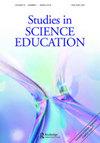翻转教室对K-16学生科学和数学成绩的影响:一项系统综述
IF 9.9
2区 教育学
Q1 EDUCATION & EDUCATIONAL RESEARCH
引用次数: 9
摘要
摘要:翻转课堂是对教学向以学生为中心和积极学习方法转变的一种回应,以促进学生在STEM中的学习。然而,翻转课堂的设计和实施及其对学生学习的影响一直存在不一致之处。这篇综述系统地分析了30项关于正式、K-16科学和数学课堂中翻转课堂的实证研究,以了解导致翻转课堂不同方法的理论基础,以及翻转课堂对学生在科学和数学教室中学习的影响。对所选研究进行了定性分析,结果表明:(1)在中学后科学和数学课堂中,有更多关于翻转课堂的已发表文献,(2)翻转课堂的设计很少以理论框架为基础,尤其是在科学课堂中,(3)翻转课堂对学生的科学和数学学习具有整体的积极影响。本研究强调了使用与当代学习理论相一致的明确理论框架来指导翻转课堂的设计、实施和评估的重要性。此外,未来的研究需要利用基于设计的方法,最大限度地发挥翻转课堂对学生学习的积极影响。本文章由计算机程序翻译,如有差异,请以英文原文为准。
The effects of flipped classrooms on K-16 students’ science and math achievement: a systematic review
ABSTRACT One response to a pedagogical shift towards student-centred and active learning approaches to promote student learning in STEM is the flipped classroom. However, there has been inconsistency in the design and implementation of the flipped classroom and its impact on student learning. This review systematically analysed 30 empirical studies on flipped classrooms in formal, K-16 science and maths classrooms to understand theoretical underpinnings leading to different approaches to flipped classrooms and the impact of flipped classrooms on student learning in science and maths classrooms. The selected studies were qualitatively analysed, and the results showed that: (1) there is more published literature on the flipped classroom identified in post-secondary science and mathematics classrooms, (2) the design of the flipped classroom is rarely grounded in theoretical frameworks especially in science classrooms, and (3) the flipped classroom has an overall positive effect on students’ science and maths learning. This study highlights the importance of using explicit theoretical frameworks aligned with contemporary learning theories to guide the design, implementation, and evaluation of the flipped classroom. Additionally, there is a need for future research to utilise design-based methodologies to maximise the positive impact of the flipped classroom on student learning.
求助全文
通过发布文献求助,成功后即可免费获取论文全文。
去求助
来源期刊

Studies in Science Education
EDUCATION, SCIENTIFIC DISCIPLINES-
CiteScore
15.30
自引率
2.00%
发文量
7
审稿时长
>12 weeks
期刊介绍:
The central aim of Studies in Science Education is to publish review articles of the highest quality which provide analytical syntheses of research into key topics and issues in science education. In addressing this aim, the Editor and Editorial Advisory Board, are guided by a commitment to:
maintaining and developing the highest standards of scholarship associated with the journal;
publishing articles from as wide a range of authors as possible, in relation both to professional background and country of origin;
publishing articles which serve both to consolidate and reflect upon existing fields of study and to promote new areas for research activity.
Studies in Science Education will be of interest to all those involved in science education including: science education researchers, doctoral and masters students; science teachers at elementary, high school and university levels; science education policy makers; science education curriculum developers and text book writers.
Articles featured in Studies in Science Education have been made available either following invitation from the Editor or through potential contributors offering pieces. Given the substantial nature of the review articles, the Editor is willing to give informal feedback on the suitability of proposals though all contributions, whether invited or not, are subject to full peer review. A limited number of books of special interest and concern to those involved in science education are normally reviewed in each volume.
 求助内容:
求助内容: 应助结果提醒方式:
应助结果提醒方式:


